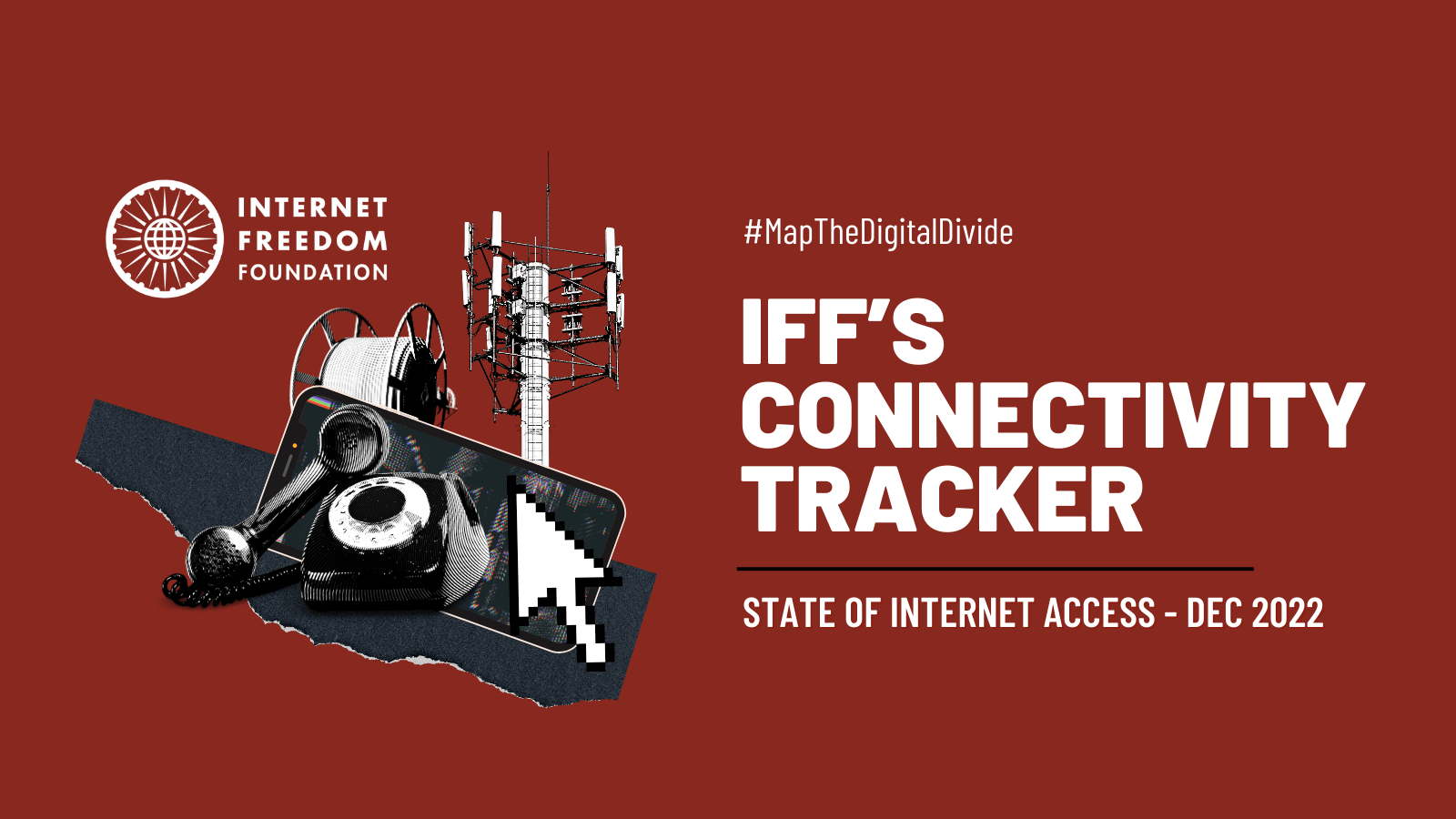
tl;dr
IFF’s #connectivitytracker for December 2022 is here! Our report provides an overview of the state of internet access from January 2020 to September 2022, with a special emphasis on tracking changes from October 2021 onwards. In this edition of the report, we analyse data on telecom and broadband connectivity, the digital divide in the context of the Mobile Gender Gap Report, 2022, released by the Global System for Mobile communications Association (“GSMA”), and the progress of government schemes aimed at improving internet access.
Introduction
Internet access is an extremely significant right, with invaluable benefits in day-to-day life. Especially in the context of developing countries, internet connectivity can boost businesses, education, information symmetries, and thus, overall development. The after-effects of COVID-19 have also revealed a populace that is more and more reliant on online tools, be it for school, work, or procuring goods and services.
Thus, it becomes essential to study the digital divide on a routine basis, to analyze the status quo and identify the hits and the misses of the attempts being made to eradicate it. To further this endeavor, IFF released its first connectivity tracker in November 2021, which created a consolidated database for all statistics pertaining to telephone and internet access in the country. This was followed by the second edition of the connectivity tracker that published a similar analysis, but with specific focus on the divide in accessing online education.
Here, we discuss the four key takeaways from our connectivity tracker report for September 2022. Our primary sources for this analysis were the Telecom Regulatory Authority’s Telecom Subscription Reports and their monthly, quarterly, and yearly publications. For the full report, please see here.
Drop in number of telephone subscribers
The number of wireless telephone subscribers decreased to 1145.45 million by the end of September 2022, from 1166.3 million in October 2021 and 1177.02 million in January 2020, with a marginal monthly growth rate of -0.27%. The monthly growth rate of subscribers showed a negative trend from December 2021 to February 2022, after which it showed a positive trend till August 31, 2022, reflecting an increase of 0.77% since February 2022. However, by the end of September 2022, the monthly growth rate took a negative turn again, becoming -0.27%. As for total telephone subscribers, as of September 2022, the numbers again dipped to 1171.92 from 1175.08 in August 2022, and 1189.62 in October 2021.
Figure 1: The total telephone subscribers dipped from January 2020 till January 2021, rising significantly in September 2021, falling gradually and consistently, with only a slight increase in September 2022
Figure 2: Wireless telecom subscribers rose from June 2020 till August 2021, followed by decline till February 2022. While it saw a gradual rise till August 2022, it registered a dip in September 2022
Broadband subscribers in India: Slowed growth since October 2021
The total number of broadband subscribers increased to 836.86 million by the end of the second quarter of 2022 (compared to 824.89 million in the first quarter of 2022, with 1.45% change over the previous quarter. This translated to a slight increase in the overall internet penetration rate (number of internet subscribers per 100 population), which changed from 60% to 60.73%. Broadband subscribers rose at a steady rate from April 2020 till August 2021, after which it saw inconsistent dips and growth. As of September 2022, the total number of broadband subscribers was 816.24 million, growing from 813.94 at the end of August 2022. Between January 2020 and September 2022, the total number of broadband subscribers has increased by a compounded annual growth rate of 0.57%.
Figure 3: The total number of broadband subscribers saw a sustained rise from January 2020 up till September 2022, when it reached a record high
Gender-based access to mobile and Internet - Disparities continue
According to The Mobile Gender Gap Report 2022 published by the GSMA, smartphone ownership and mobile internet use in India have grown steadily for men since 2019, however it still remains uncommon among women. Although market conditions and COVID-induced lockdowns between 2019 and 2020 helped provide justification for women to obtain smartphones and use mobile internet, leading to a significant jump in the usage of mobile internet by women. In 2021, the proportion of women using mobile internet remained stagnant and smartphone ownership saw no growth as well. In comparison, the proportion of Indian men using mobile internet in this period grew from 45% to 51%, and smartphone ownership rose from 41% to 49%.
Figure 4: Women’s mobile internet usage remained stagnant in 2021 at the 2020 levels, while men’s numbers rose by 6%
Slow progression of government schemes to increase internet access
To combat the digital divide, the government had launched two ambitious schemes - PMGDISHA and BharatNet. As on date, both schemes significantly lag behind in fulfilling their targets. Under the PMGDISHA, 2.32 lakh PMGDISHA training centers were operational as on December 15, 2022. This is against the 2.5 lakh center target set at the launch of the scheme in 2018.
A total of 6.59 crore candidates have been enrolled, and 5.66 crore have been trained, of which 4.21 crore candidates have been certified under the PMGDISHA Scheme. BharatNet continues to be marred with slow pace. As on December 8, 2022, a total number of 1,84,399 GPs have been made service ready. The scope of BharatNet has been extended up to all inhabited villages beyond Gram Panchayats in the country. As per available data, the funds allocated/disbursed under the BharatNet Project as of March 31, 2022 was ₹ 22,676 crores.
Important Documents
- State of Internet Access: December 2022 (link)
- State of Internet Access: January 2022 (link).
- State of Internet Access: November 2021 (link)
- Public view sheets with compiled data for Telecom Subscription Data (link)
- Public view sheet with compiled data for Performance Indicator Reports (link)
This post was drafted by Policy Intern Mannat Marwah, who is a fifth-year student at Symbiosis Law School, NOIDA.

